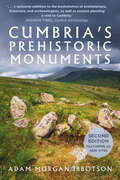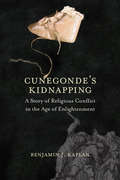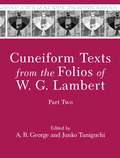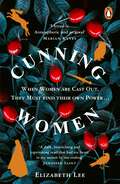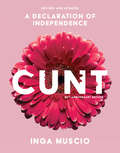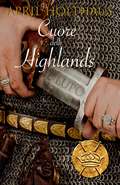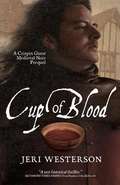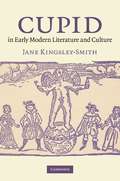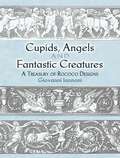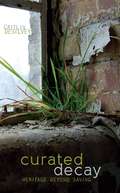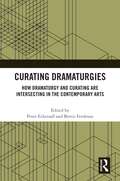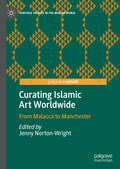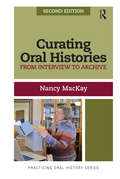- Table View
- List View
Cumbria's Prehistoric Monuments
by Adam Morgan IbbotsonCumbria is a land built from stone.Whether it is Hadrian's Wall, Kendal Castle or the beautiful fells of the Lake District – for thousands of years people have found a certain elegance and utility in stone. Nestled amongst these common relics are a multitude of massive stone monuments, built over 3,000 years before British shores were ever touched by Roman sandals. Cumbria’s 'megalithic' monuments are among Europe's greatest and best-preserved ancient relics but are often poorly understood and rarely visited.This updated and revised edition of Cumbria’s Prehistoric Monuments aims to dispel the idea that these stones are merely ‘mysterious’. Within this book you will find credible answers, using up-to-date research, excavation notes, maps and diagrams to explore one of Britain's richest archaeological landscapes. Featuring stunning original photography and illustrated diagrams of every megalithic site in the county, Adam Morgan Ibbotson invites you to take a journey into a land sculpted by ancient hands.
Cunegonde's Kidnapping
by Benjamin J. KaplanIn a remote village on the Dutch-German border, a young Catholic woman named Cunegonde tries to kidnap a baby to prevent it from being baptized in a Protestant church. When she is arrested, fellow Catholics stage an armed raid to free her from detention. These dramatic events of 1762 triggered a cycle of violence, starting a kind of religious war in the village and its surrounding region. Contradicting our current understanding, this war erupted at the height of the Age of Enlightenment, famous for its religious toleration. Cunegonde’s Kidnapping tells in vivid detail the story of this hitherto unknown conflict. Drawing characters, scenes, and dialogue straight from a body of exceptional primary sources, it is the first microhistorical study of religious conflict and toleration in early modern Europe. In it, Benjamin J. Kaplan explores the dilemmas of interfaith marriage and the special character of religious life in a borderland, where religious dissenters enjoy unique freedoms. He also challenges assumptions about the impact of Enlightenment thought and suggests that, on a popular level, some parts of eighteenth-century Europe may not have witnessed a #147;rise of toleration. ”
Cuneiform Texts and the Writing of History
by Marc Van MieroopCuneiform Texts and the Writing of History discusses how the abundant Mesopotamian cuneiform text sources can be used for the study of various aspects of history: political, social, economic and gender. Marc Van De Mieroop provides a student-friendly introduction to the subject and:* criticises disciplinary methodologies which are often informed by a desire to write a history of events* scrutinises the intellectual background of historical writings* examines how Mesopotamia's position as the 'other' in Classical and Biblical writings has influenced scholarship* illustrates approaches with examples taken from the entirety of Mesopotamian history.
Cuneiform Texts from the Folios of W. G. Lambert, Part Two (Mesopotamian Civilizations #25)
by A. R. George, Junko TaniguchiThis book publishes 323 handcopies of cuneiform tablets found in the academic papers of W. G. Lambert (1926–2011), one of the foremost Assyriologists of the twentieth century. Prepared by A. R. George and Junko Taniguchi, it completes a two-part edition of Lambert’s previously unpublished handcopies.Written by Babylonian and Assyrian scribes in ancient Mesopotamia, the texts collected here are organized by genre and presented with a descriptive catalogue and indexes. The contents include omen literature, divinatory rituals, religious texts, a scribal parody of Babylonian scholarship, theological and religious texts, lexical lists, god lists, and a small group of miscellaneous texts of various genres. The tablets are mainly from the British Museum, but some come from museums in Baghdad, Berlin, Chicago, Geneva, Istanbul, Jerusalem, New Haven, Oxford, Paris, Philadelphia, Tokyo, Toronto, and Washington. In addition, there are copies of eight tablets whose current whereabouts are unknown.This third collection of Lambert’s handcopies published by Eisenbrauns—following Babylonian Creation Myths and Cuneiform Texts from the Folios of W. G. Lambert, Part One—is a crucial part of the intellectual history of the field of Assyriology. In addition, many of these texts are published herein for the first time, making them a valuable and important resource for further study.
Cuneiform Texts from the Folios of W. G. Lambert, Part Two (Mesopotamian Civilizations)
by A. R. George, Junko TaniguchiThis book publishes 323 handcopies of cuneiform tablets found in the academic papers of W. G. Lambert (1926–2011), one of the foremost Assyriologists of the twentieth century. Prepared by A. R. George and Junko Taniguchi, it completes a two-part edition of Lambert’s previously unpublished handcopies.Written by Babylonian and Assyrian scribes in ancient Mesopotamia, the texts collected here are organized by genre and presented with a descriptive catalogue and indexes. The contents include omen literature, divinatory rituals, religious texts, a scribal parody of Babylonian scholarship, theological and religious texts, lexical lists, god lists, and a small group of miscellaneous texts of various genres. The tablets are mainly from the British Museum, but some come from museums in Baghdad, Berlin, Chicago, Geneva, Istanbul, Jerusalem, New Haven, Oxford, Paris, Philadelphia, Tokyo, Toronto, and Washington. In addition, there are copies of eight tablets whose current whereabouts are unknown.This third collection of Lambert’s handcopies published by Eisenbrauns—following Babylonian Creation Myths and Cuneiform Texts from the Folios of W. G. Lambert, Part One—is a crucial part of the intellectual history of the field of Assyriology. In addition, many of these texts are published herein for the first time, making them a valuable and important resource for further study.
Cunk on Everything: The Encyclopedia Philomena
by Philomena CunkA VULTURE BEST COMEDY BOOK OF 2023 From the star of the &“deeply funny, unexpectedly informative&” (The Daily Beast) Netflix mockumentary Cunk on Earth, a helpful guide covering every single topic in the known universe, from Adam and Eve to Top Gun. Once in a blue moon, a book comes along that changes the world. The Origin of Species. War and Peace. 1984. And now, Cunk on Everything: The Encyclopedia Philomena, by Philomena Cunk. Philomena Cunk is one of the greatest thinkers of the 21st century, and in Cunk on Everything she turns her attention to our biggest issue: why are there so many books? Wouldn't it be better if there was just one? This is that book — an encyclopedia of all human knowledge, delving into not only life's greatest mysteries but our most important political figures and cultural touchstones. Read it, and you'll never have to read another book again.
Cunning Women: A feminist tale of forbidden love after the witch trials
by Elizabeth LeeONE OF GRAZIA'S BEST BOOKS OF 2021'I loved it. Atmospheric and so good' MARIAN KEYES 'A dark, bewitching and captivating read that had my heart in my mouth by the ending' JENNIFER SAINT, author of ARIADNELancashire, 1620. Young Sarah Haworth and her family live as outcasts. They are 'cunning folk', feared by the local villagers by day, but called upon under cover of darkness for healing balms and spells.Against the odds, love blossoms when Sarah meets Daniel, the local farmer's son.But when a new magistrate arrives to investigate a spate of strange deaths, his gaze inevitably turns to Sarah and her family. In a world where cunning women are forced into darkness by powerful men, can Sarah reckon with her fate to protect all she holds dear?'Fans of intensely atmospheric historical fiction will love this' STYLIST'Elizabeth Lee's debut novel is timely in its depiction of hysteria and persecution, and beautifully evokes a historical period poised between dark ignorance and long-overdue enlightenment' OBSERVER'Wonderfully original . . . devastating . . . and fabulously atmospheric' ELODIE HARPER, author of THE WOLF DEN
Cunt, 20th Anniversary Edition: A Declaration Of Independence (Live Girls)
by Inga MuscioAn ancient title of respect for women, the word "cunt" long ago veered off this noble path. Inga Muscio traces the road from honor to expletive, giving women the motivation and tools to claim "cunt" as a positive and powerful force in their lives. With humor and candor, she shares her own history as she explores the cultural forces that influence women's relationships with their bodies.Sending out a call for every woman to be the Cuntlovin' Ruler of Her Sexual Universe, Muscio stands convention on its head by embracing all things cunt-related.This updated edition features a new foreword by Betty Dodson, an introduction by Derrick Jensen, a new afterword by the author and an updated and expanded resource section.
Cuori delle Highlands. Il Lupo
by Adele Contenti April HolthausRylan ha trascorso la maggior parte della vita mantenendo segreta la sua identità, anche a coloro che ama. Ma al fine di rendere sicuro il proprio futuro, deve affrontare il passato. In fuga come un fuorilegge, cercando di restituire onore al suo nome, Rylan si imbatte in una donna che sembra avere segreti altrettanto oscuri. La vita di Fallon e di suo figlio scorre tranquilla finchè un Highlander non compare sulla porta di casa, gettando il suo mondo nel caos e nell'inganno. E allora, si ritrova davanti ad un bivio che può influenzare entrambe le loro vite. Quando i segreti verranno rivelati, riuscirà Fallon a scegliere la strada giusta, e, soprattutto, a salvare Rylan dal patibolo?
Cup Of Blood: A Medieval Noir (Crispin Guest Novel Prequel)
by Jeri WestersonWhen a corpse turns up at his favorite tavern, Crispin Guest-disgraced knight turned detective--begins an inquiry, but the dead man turns out to be a Templar knight, an order thought to be extinct for 75 years, charged with protecting a certain religious relic which is now missing. Before he can begin to investigate, Crispin is abducted by shadowy men who are said to be minions of the French anti-pope. Further complicating matters are two women: one from court with an enticing proposition, and another from Crispin's past, dredging up long-forgotten emotions he would rather have left behind. And as if all that weren't enough, a cunning young cutpurse by the name of Jack Tucker has insinuated himself into Crispin's already difficult life. The deeper Crispin probes into the murder, the more it looks like the handiwork of an old friend turned adversary. With enemies from all sides, Crispin has his hands full in more than murder in this intriguing prequel to the acclaimed series.
Cup of Blood . . . Bread of Salvation (The Dark Ages Saga of Tristan de Saint-Germain #Vol. 5)
by Robert E. HirschAn epic novel of the Crusades, the siege of Antioch, and a man and woman swept up in the bloody quest to reach Jerusalem. In 1097, Pope Urban&’s Army of God confronts the great city of Antioch, the final obstacle before reclaiming Jerusalem from the hammer of Islam. But Antioch is defended by the wily Turcoman, Emir Yaghi Siyan, and is coveted by the atabeg of Mosul, Kerbogha. After overcoming a tortuous trail of impossibility, separation, and heartbreak, Bishop Tristan de Saint-Germain and Mala the Romani finally stand at the precipice of a new life together. However, Antioch snares them both, forcing Tristan to decide between honoring his &“father&” in this life, Pope Urban II, or abandoning Catholicism forever in favor of exile with Mala in the Middle East. Appearing unexpectedly in the midst of this crucible, honorable Lord Abdul Azim and murderous Mahmoud Malik create further complexities, bringing together in one final episode all the primary characters of the Dark Ages Saga of Tristan de Saint-Germain, including Peter the Hermit, treacherous Desmond DuLac, Tafur the Beggar King, and Bishop Adhémar of Le Puy. Will the forces of God prevail or those of Allah?
Cup of Gold: A Life of Sir Henry Morgan, Buccaneer, with Occasional Reference to History (Dover Thrift Editions: Classic Novels)
by John SteinbeckIn this remarkable debut novel, John Steinbeck, the esteemed author of the Pulitzer Prize–winning masterpiece The Grapes of Wrath, brings to life the enigmatic tale of Sir Henry Morgan — a legendary pirate from the 1600s whose adventures spanned the coasts of Cuba and mainland Latin America, leaving a lasting mark on the ravaged lands of Panama. Treading the line between history and fantasy, Steinbeck weaves an enthralling swashbuckling narrative of a buccaneer’s search for fame, fortune, and romance by conquering Panama, the “cup of gold,” and possessing the beautiful woman called La Santa Roja. The glimpses of Steinbeck’s genius within this work, which was published to mixed reviews in 1929, foreshadow his emergence as one of the twentieth century’s most celebrated and critically acclaimed authors.
Cupboards of Curiosity: Women, Recollection, and Film History
by Amelie HastieIn Cupboards of Curiosity Amelie Hastie rethinks female authorship within film history by expanding the historical archive to include dollhouses, scrapbooks, memoirs, cookbooks, and ephemera. Focusing on women who worked during the silent-film era, Hastie reveals how female stars, directors, and others appropriated personal or "domestic" cultural forms not only to publicize their own achievements but also to reflect on specific films and the broader film industry. Whether considering Colleen Moore's thirty-six scrapbooks or Dietrich's eccentric book Marlene Dietrich's ABC, Hastie emphasizes how these women spoke for themselves--as collectors, historians, critics, and experts--often explicitly contemplating the role their writings and material objects would play in subsequent constructions of history.Hastie pays particular attention to the actresses Colleen Moore and Louise Brooks and Hollywood's first female director, Alice Guy-Blaché. From the beginning of her career, Moore worked intently to preserve a lasting place for herself as a Hollywood star, amassing collections of photos, souvenirs, and clippings as well as a dollhouse so elaborate that it drew extensive public attention. Brooks's short essays reveal how she participated in the creation of her image as Lulu and later emerged as a critic of film stardom. The recovery of Blaché's role in film history by feminist critics in the 1970s and 1980s was made possible by the existence of the director's own autobiographical history. Broadening her analytical framework to include contemporary celebrities, Hastie turns to how-to manuals authored by female stars, from Zasu Pitts's cookbook Candy Hits to Christy Turlington's Living Yoga. She discusses how these assertions of celebrity expertise in realms seemingly unrelated to film and visual culture allow fans to prolong their experience of stardom.
Cupid in Early Modern Literature and Culture
by Jane Kingsley-SmithCupid became a popular figure in the literary and visual culture of post-Reformation England. He served to articulate and debate the new Protestant theory of desire, inspiring a dark version of love tragedy in which Cupid kills. But he was also implicated in other controversies, as the object of idolatrous, Catholic worship and as an adversary to female rule: Elizabeth I's encounters with Cupid were a crucial feature of her image-construction and changed subtly throughout her reign. Covering a wide variety of material such as paintings, emblems and jewellery, but focusing mainly on poetry and drama, including works by Sidney, Shakespeare, Marlowe and Spenser, Kingsley-Smith illuminates the Protestant struggle to categorise and control desire and the ways in which Cupid disrupted this process. An original perspective on early modern desire, the book will appeal to anyone interested in the literature, drama, gender politics and art history of the English Renaissance.
Cupid's Apple
by Olga KryuchkovaSergei Lvovich Zavyalov, an artillery major, takes a holiday to visit his aunt Aglaya Dmitrievna. At his aunt’s insistence, Zavyalov begins courting their neighbour, Polina Veresova. They have a night of love in a hunting lodge. Polina’s intimate diary falls into the man’s hands. Sergei Lvovich is shocked and immediately leaves the love nest. He leaves the welcome home of his aunt Aglaya Dmitrievna without further explanation and goes to visit a friend. The upset aunt gathers a basket of apples for her nephew’s journey. Zavyalov boards a train and finds himself in a carriage with a teenage boy and his English tutor. The major has no idea that this is to become a fateful encounter for him. Meanwhile, in provocation the teenager takes an apple from Zavyalov’s basket without asking. In response, the young troublemaker receives a hefty slap from the major. A scandal erupts. At this point, Polina realises that Sergei has run away. She decides to go after him and explain herself no matter what the cost. Zavyalov gets safely to his army friend Sobolev’s estate. Soon enough, Polina arrives and gets a room at a nearby inn. Sobolev and Zavyalov go off hunting. They find a poacher on Sobolev’s grounds. Zavyalov recognises him as the Englishman from the train. Meanwhile, Polina is spying on Zavyalov and gets caught in the rain. She decides to hide in a small barn next to Sobolev’s estate. By the will of destiny, the Englishman happens to be wandering in that direction...
Cupids, Angels and Fantastic Creatures: A Treasury of Rococo Designs (Dover Pictorial Archive)
by Giovanni IannoniCharacterized by opulence, grace and playfulness, rococo designs are a complex mix of intricate patterns. This affordable treasury of fantastic ornament and design includes more than 100 illustrations of Rococo art. Mythological figures, angels, and cherubs in traditional poses abound--as do real and fanciful beasts and other images from nature.An excellent source of royalty-free illustrations for artists and designers, this collection of ornate frames, panels, and borders is perfect for use in a number of graphic design projects--for enhancing printed messages, creating decorative labels, and fashioning exquisite collages, among other art and craft activities.
Curated Decay: Heritage beyond Saving
by Caitlin DeSilveyTransporting readers from derelict homesteads to imperiled harbors, postindustrial ruins to Cold War test sites, Curated Decay presents an unparalleled provocation to conventional thinking on the conservation of cultural heritage. Caitlin DeSilvey proposes rethinking the care of certain vulnerable sites in terms of ecology and entropy, and explains how we must adopt an ethical stance that allows us to collaborate with—rather than defend against—natural processes. Curated Decay chronicles DeSilvey&’s travels to places where experiments in curated ruination and creative collapse are under way, or under consideration. It uses case studies from the United States, Europe, and elsewhere to explore how objects and structures produce meaning not only in their preservation and persistence, but also in their decay and disintegration. Through accessible and engaging discussion of specific places and their stories, it traces how cultural memory is generated in encounters with ephemeral artifacts and architectures. An interdisciplinary reframing of the concept of the ruin that combines historical and philosophical depth with attentive storytelling, Curated Decay represents the first attempt to apply new theories of materiality and ecology to the concerns of critical heritage studies.
Curating Difficult Knowledge
by Erica Lehrer Cynthia E. Milton Monica Eileen PattersonThis volume inscribes an innovative domain of inquiry, bringing museum and heritage studies to bear on questions of transitional justice, memory and post-conflict reconciliation. As practitioners, artists, curators, activists and academics, the contributorsexplore the challenges of bearing witness to past conflicts. "
Curating Dramaturgies: How Dramaturgy and Curatorial Practices are Intersecting in the Contemporary Arts
by Peter Eckersall Bertie FerdmanCurating Dramaturgies investigates the transformation of art and performance and its impact on dramaturgy and curatorship. Addressing contexts and processes of the performing arts as interconnecting with visual arts, this book features interviews with leading curators, dramaturgs and programmers who are at the forefront of working in, with, and negotiating the daily practice of interdisciplinary live arts. The book offers a view of praxis that combines perspectives on theory and practice and looks at the way that various arts institutions, practitioners and cultural agents have been working to change the way that art and performance have developed and experienced by spectators in the last decade. Curating Dramaturgies argues that cultural producers and scholars are becoming more cognizant of this overlapping and transforming field. The introductory essay by the editors explores the rise of interdisciplinary live arts and its ramifications in cultural and political terms. This is further elaborated in the interviews with 15 diversely placed arts professionals who are at the forefront of rethinking and consolidatingthe ever-evolving field of the visual arts and performance.
Curating Islamic Art Worldwide: From Malacca to Manchester (Heritage Studies in the Muslim World)
by Jenny Norton-WrightThis volume gives voice to cultural institutions working with collections of Islamic art and material culture globally, including many from outside Western Europe and North America. The contributions inform a vibrant, ongoing global conversation around curatorship in this field, one that embraces the responsibilities, challenges and opportunities for those engaged in it. Contributors—including art historians, curators and education specialists—discuss curatorial methodologies in theoretical and practical terms, present new exhibitions of Islamic art and culture, and explore the role of educational and engagement practices related to Islamic collections and Muslim audiences.
Curating Lively Objects: Exhibitions Beyond Disciplines (Routledge Research in Museum Studies)
by Lizzie Muller Caroline Seck LangillCurating Lively Objects explores the role of things as catalysts in imagining futures beyond disciplines for museums and exhibitions. Authors describe how their curatorial collaborations with diverse objects, from rocks to robots, generate new ways of organising and sharing knowledge. Bringing together leading artists and curators from Australia and Canada, this volume addresses object liveliness from a range of entwined perspectives, including new materialism, decolonial thinking, Indigenous epistemologies, environmentalism, feminist critique and digital aesthetics. Foregrounding practice-based curatorial scholarship, the book focuses on rigorous reflexive accounts of how curating is done. It contributes to global topics in curatorial research, including time and memory beyond and before disciplinarity; the relationship between human and non-human across different ontologies; and the interaction between Indigenous knowledge and disciplinary expertise in interpreting museum collections. Curating Lively Objects will be of interest to scholars and students in the fields of curatorial studies, museum studies, cultural heritage, art history, Indigenous studies, material culture and anthropology. It also provides a vital resource for professionals working in museums and galleries around the world who are seeking to respond creatively, ethically and inclusively to the challenge of changing disciplinary boundaries.
Curating Opera: Reinventing the Past Through Museums of Opera and Art (Ashgate Interdisciplinary Studies in Opera)
by Stephen MouldCuration as a concept and a catchword in modern parlance has, over recent decades, become deeply ingrained in modern culture. The purpose of this study is to explore the curatorial forces at work within the modern opera house and to examine the functionaries and processes that guide them. In turn, comparisons are made with the workings of the traditional art museum, where artworks are studied, preserved, restored, displayed and contextualised – processes which are also present in the opera house. Curatorial roles in each institution are identified and described, and the role of the celebrity art curator is compared with that of the modern stage director, who has acquired previously undreamt-of licence to interrogate operatic works, overlaying them with new concepts and levels of meaning in order to reinvent and redefine the operatic repertoire for contemporary needs. A point of coalescence between the opera house and the art museum is identified, with the transformation, towards the end of the nineteenth century, of the opera house into the operatic museum. Curatorial practices in the opera house are examined, and further communalities and synergies in the way that ‘works’ are defined in each institution are explored. This study also considers the so-called ‘birth’ of opera around the start of the seventeenth century, with reference to the near-contemporary rise of the modern art museum, outlining operatic practice and performance history over the last 400 years in order to identify the curatorial practices that have historically been employed in the maintenance and development of the repertoire. This examination of the forces of curation within the modern opera house will highlight aspects of authenticity, authorial intent, preservation, restoration and historically informed performance practice.
Curating Oral Histories: From Interview to Archive (Practicing Oral History #2)
by Nancy MacKayFor the past ten years, Nancy MacKay’s Curating Oral Histories (2006) has been the one-stop shop for librarians, curators, program administrators, and project managers who are involved in turning an oral history interview into a primary research document, available for use in a repository. In this new and greatly expanded edition, MacKay uses the life cycle model to map out an expanded concept of curation, beginning with planning an oral history project and ending with access and use. The book:-guides readers, step by step, on how to make the oral history “archive ready”;-offers strategies for archiving, preserving, and presenting interviews in a digital environment;-includes comprehensive updates on technology, legal and ethical issues, oral history on the Internet, cataloging, copyright, and backlogs.
Curating at the Edge: Artists Respond to the U.S./Mexico Border
by Kate BonansingaLocated less than a mile from Juárez, the Stanlee and Gerald Rubin Center for Visual Arts at the University of Texas at El Paso is a non-collecting institution that serves the Paso del Norte region. In Curating at the Edge, Kate Bonansinga brings to life her experiences as the Rubin’s founding director, giving voice to a curatorial approach that reaches far beyond the limited scope of “border art” or Chicano art. Instead, Bonansinga captures the creative climate of 2004–2011, when contemporary art addressed broad notions of destruction and transformation, irony and subversion, gender and identity, and the impact of location on politics. The Rubin’s location in the Chihuahuan desert on the U. S. /Mexican border is meaningful and intriguing to many artists, and, consequently, Curating at the Edge describes the multiple artistic perspectives conveyed in the place-based exhibitions Bonansinga oversaw. Exciting mid-career artists featured in this collection of case studies include Margarita Cabrera, Liz Cohen, Marcos Ramírez ERRE, and many others. Recalling her experiences in vivid, first-person scenes, Bonansinga reveals the processes a contemporary art curator undertakes and the challenges she faces by describing a few of the more than sixty exhibitions that she organized during her tenure at the Rubin. She also explores the artists’ working methods and the relationship between their work and their personal and professional histories (some are Mexican citizens, some are U. S. citizens of Mexican descent, and some have ancestral ties to Europe). Timely and illuminating, Curating at the Edge sheds light on the work of the interlocutors who connect artists and their audiences.
Curating the Colonial Past: The ‘Migrated Archives' and the Struggle for Kenya's History (African Studies)
by Riley LinebaughIn the early 1960s, British colonial administrations in East Africa organized the systematic destruction and removal of secret documents from colonies approaching independence. The Colonial Office in London arranged the deposit of these documents in high security facilities, where they remained inaccessible until 2011 following a compensation suit by Kenyan survivors of British colonial rule against the Foreign and Commonwealth Office. Curating the Colonial Past presents the first full length exploration of these 'migrated archives', chronicling the struggle between British attempts to conceal and Kenyan efforts to reveal evidence of the colonial past. Neither displayed nor destroyed, Riley Linebaugh explores how these records formed an archival limbo in which the British government delayed moral and legal judgement of empire. Yet, these practices did not go unchallenged. Linebaugh demonstrates how disputes over the 'migrated archives' facilitated the continuation of anticolonial sovereignty struggles beyond independence, struggles which persist into the present.
